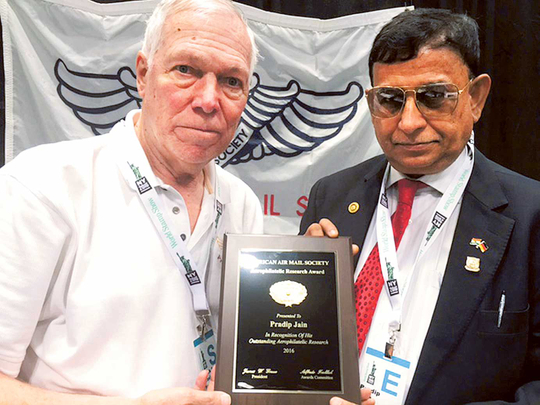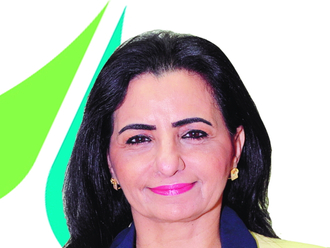
It was past 5pm on February 18, 1911, when Henri Pequet’s two-seater Humber-Sommer biplane landed at a cleared-out spot near the Naini railway station. Pequet handed over the mail bag, containing 6,500 cards and letters, to the lone post office employee present there and returned to Allahabad. This nondescript transaction, sans any kind of fanfare, was a moment in history of India and the world that marked the delivery of the first official airmail.
And this little tidbit of history is part of the collection of Pradip Jain, an avid philatelist from Patna, Bihar. Jain is proud of these stamps that tell the story of how airmail developed and expanded. Over the last 40 years, he has been honoured with several medals and citations at national as well as international platforms for his remarkable collections. He was also named Fellow of the Royal Philatelic Society, London in 2015.
The most recent accolade was when he and his son Pragya showcased their entries at the World Stamp Show in New York, in which 120 countries participated. The eight-day philately show at Javits Centre attracted more than 250,000 visitors. Aspiring participants had to file their entry a year prior to the exhibition and the final participants were chosen on the basis of the merits of their collection. The categories were traditional, aero philately, postal history, postal station, literature, thematics and open class.
Pradip Jain receives the American Air Mail Society's Outstanding Aerophilatelic Research Award, 2016
While Pradip Jain showcased his collection on the Mahatma Gandhi memorial issue of 1948, Pragya exhibited his compilation on “A study of first issues of India 1852-1854”.
Jain has also published several related research papers. “Like any youngster interested in collecting stamps, I became an amateur stamp collector,” he says.
Talking about Pequet’s flight carrying the first airmail, Jain says, “It’s a matter of pride for Allahabad in Uttar Pradesh, famous for its Kumbh Mela.” French pilot Pequet was just 23 years old when he took off on his biplane stationed at a polo field in Allahabad, then the capital of the United Provinces of Agra and Oudh, and soared into the sky. Thousands viewed the take-off, including those who had come for the Kumbh Mela. The flight took 13 minutes to cover a distance of 15 kilometres to and from the Naini railway station. The spot where the aircraft landed had been cleared by the convicts in the central jail.
“The mails included a letter from Motilal Nehru, the founder of the Nehru-Gandhi dynasty and father of India’s first prime minister, Jawaharlal Nehru. Other letters were addressed to the Queen of the Netherlands and King George V. The ones sent to the King are even now preserved in the Buckingham Palace, London,” Jain says.
Motilal Nehru’s letter was addressed to Jawaharlal Nehru, who was studying in Holland Park School in London at that time, and he mentioned in the letter that it was being sent through the world’s first airmail.
Prior to the event, several planes were brought to India by sea, probably to test the worthiness for the attempt. And the event was conceived as a plan to raise money for a new hostel building by W.E.S. Holland, the chaplain of Allahabad city’s Holy Trinity Church and warden of Oxford and Cambridge hostels, and Sir Walter Windham, the adventurer who organised Britain’s first airmail flight later the same year.
According to the Allahabad region postal services department, Holland had approached Windham to help him raise funds for a new church hostel building. Windham sensed that airmail could not only do the trick, but also serve as an advertisement and publicise the large industrial exhibition that was to be held in the city. The idea demonstrated the rapid and safe transportation of mails. On obtaining approval from the post office for officially sanctioned mail, Holland then appealed to the people to help in fundraising.
Postal officials had asked Windham to design the cancel. Meanwhile, people across the region, keen on availing the service, were asked to send their mail to the Holy Trinity Church. All the letters were then marked with a special official magenta cancellation (though some mails also exist with black ink marks) bearing the words “First Aerial Post, 1911, U.P. Exhibition Allahabad” and depicted an airplane and mountains.
A nominal sum of six annas (old Indian currency), as additional surcharge, was sought as donation for the hostel building and only envelopes that contained cards or letters weighing less than an ounce were accepted. Since it was considered a ceremonial occasion, these letters were addressed to people across the world.
“The flight revolutionised the nature of transport and proved that heavy cargo could be dispatched by air,” says Jain, who wrote “Indian Airmails: Development and Operations (1911-1942)”. “Until then, pilots had been carrying only some small bundles of letters.”
An official of the postal department says, “Before landing, Pequet had flown over the River Ganges on the plane with a rotary Gnome engine of 50 horsepower at a speed of 60 miles [97 kilometres] per hour, at an altitude of 120-150 feet. He told a French air force magazine that he was not too sure if he would actually make it. But did manage to create history. He died in 1974 at the age of 86.”
Up in the air
- During the 1800s, balloons and gliders carried the first flown mail.
- On December 17, 1903, brothers Orville and Wilbur Wright made the first sustained, powered airplane flight at Kitty Hawk in North Carolina. Orville flew 120 feet for 12 seconds. But no mail was carried.
- During the following decade, pilots around the world barnstormed the countryside, holding aerial demonstrations, creating postcards and souvenir labels. Many pioneer pilots carried unofficial mail (these were carried privately and postmarked before or after the flight) on their short flights.
- The first official US airmail delivery took place on August 17, 1859. On that day, veteran balloonist John Wise carried 123 letters and 23 circulars from Lafayette to Crawfordsville, Indiana, a distance of 30 miles [48 kilometres], in his balloon Jupiter.
- On the basis of the successful experiment in India, the world’s first scheduled airmail post service took place in the UK between the North London suburb of Hendon, and the Postmaster General’s office in Windsor, Berkshire, on September 9, 1911, as part of the celebrations for King George V’s coronation.
- To commemorate the Allahabad-Naini airmail occasion 100 years later, India Post re-enacted that historic moment with a special flight between Allahabad and Naini on February 12, 2011, which also marked the beginning of Indipex 2011, the world philatelic exhibition held each year in New Delhi.
–From Smithsonian’s National Postal Museum Blog
Nilima Pathak is a journalist based in New Delhi.












